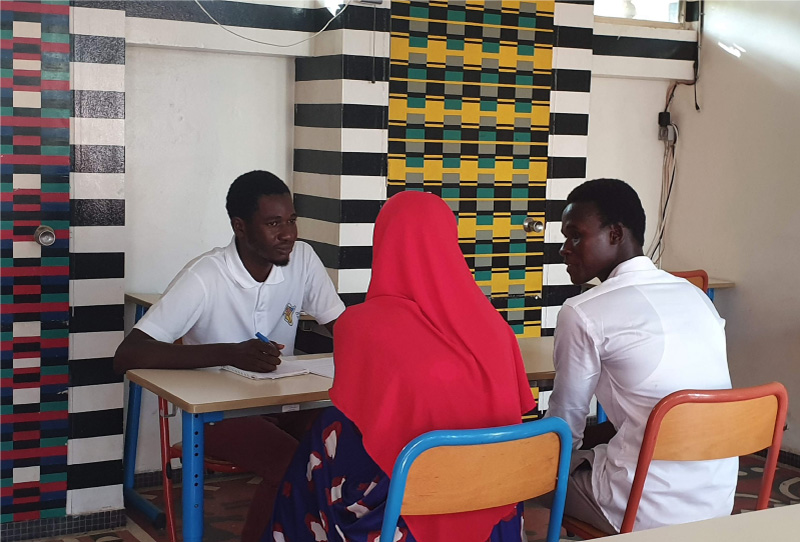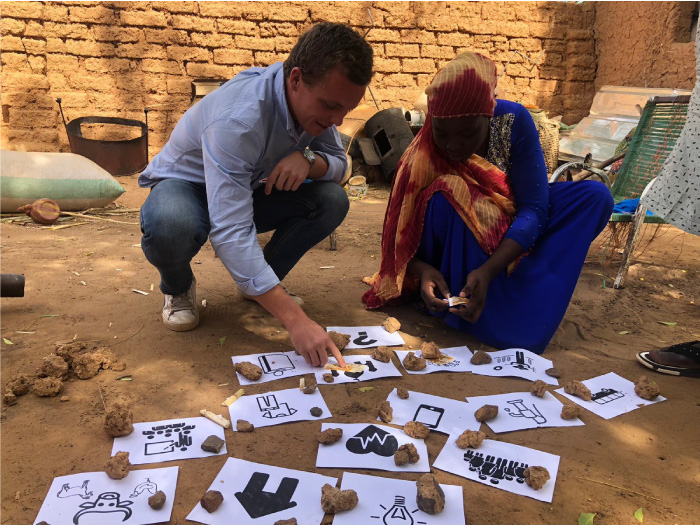Yux design process? This is how it works!
Our goal at YUX is to design digital projects and innovative services that meet the needs of African populations.
For the past four years, we have been working with large companies, start-ups and international organizations in the fields of telecom, fintech, health, education and more. These collaborations have allowed us to consolidate our expertise and create our own innovation process - a process where human beings, their needs and aspirations are at the center of our approach to create ideal experiences.
Planification
- Client meeting
- Define mission & objectives
- Retro planning
Retro Planning - Kick off
RACI
Core Team
Exploration
- DESK RESEARCH
Desk research with analysis - STAKEHOLDER INTERVIEWS
Reports and Analysis - AUDIT OF THE EXISTING (UX-UI)
Reports and Priorization - BENCHMARK (UX-UI)
Reports and Strategic Positioning Workshop - USER OBSERVATIONS
Observation guide
Observation
Synthesis
Photos - USER INTERVIEWS
Interview Guide
Synthesis
Photos, Videos, Sound Captation - FOCUS GROUPS
Guide
Reports Synthesis
Photos, Videos, Sound Captation - RECRUITMENT (INCENTIVES)
No deliverables (data protection) - LOOKA
YUX Business Unit
Market Research
Quanti questionnaires and Synthesis
Définition
- All are deliverables from the exploration
- ECOSYSTEM MAPPERSONAE
Only use if we have a huge amount of quali or quanti - USER PROFILS
- CUSTOMER JOURNEY
- STRUCTURING LEARNINGS
- AREAS OPPORTUNITIES
Idéation
- CREATIVE SESSIONS IN HOUSE
Lots of Ideas, Scenarii, Storyboarding,Storytelling, Prototypes Low Fidelity - CO-CREATION WITH USERS
Reports and analysis
Sound
Captation, Videos, Photos
Experiences Prioritization - STORYBOARDING
- STORYTELLING
- PRIORITIZATION MATRIX
Services, Functionalities prioritization matrix - BUSINESS STRATEGY
Product Box
Business Model Canvas
MoscoW
Prototype & test
- INFO ARCHITECTURE
- WORKFLOW
- WIREFRAMES
- LOW FIDELITY PROTOTYPES
- HIGH FIDELITY PROTOTYPES
- USER TEST
- VISUAL USER INTERFACE (UI)
Implémentation
- PRODUCT ROADMAP
- DESIGN SYSTEM
- BACKLOG
- COLLECT FEEDBACKS
- USAGE TRACKING
In our opinion, creating a synergy between teams of sociologists, anthropologists, designers, developers and marketing allows us to anticipate the technical and technological constraints we might face.
Working with a diverse range of countries in West, East and Central Africa, the YUX team realised that some of the tools currently used in the Western world were not providing sufficient results to create innovative solutions on the African continent.
At YUX, we have adapted this approach to the African economic and social context in which we live and work, in order to create accessible and enjoyable experiences for the populations in question.
Although our approach was built from our experience and is tailored to our context, it is nonetheless based on the classic user-centered design approach. What is changing is our tools. Although we perform ethnographic studies, including observations, immersions and interviews in many countries, the results will never be what you were expecting!!
As an example, let's take Senegal, a country where the majority of the population works in the informal sector. When we need to go and observe jobs or situations, we don't make appointments with people, we go directly in the streets to interview them; it is almost impossible to go unnoticed! There will always be an invitation to share a thieboudian or an attaya! We take our time to evaluate the complexity of the environment in which the project will evolve, which will allow us to develop pertinent concepts.
This process breaks down into six phases that coordinate and orchestrate true innovations.

The planning phase
This first step in our projects is the most complex by far, because if the framing of the project is badly done it can jeopardize the whole process!
It is, therefore, necessary to create a core dedicated team for the project, both at the client and at YUX.. The people taking part in the project from the study to the design part are defined from the get-go.
But it isn’t enough to place people according to their skills, we also need to understand and be globally in line with the client’s or partner’s expected goals.
This "brief," as we could call it, will be obtained through in-depth conversations with all of the project’s stakeholders. It is necessary to be meticulous in order not to miss possible opportunities and to create a collective vision.
"You need to have a global view of a service or system to know where to focus in terms of design”.
Camille, UX researcher
The exploration phase
The exploration phase can be divided into two approaches, qualitative and quantitative. The qualitative phase is the ethnographic-study part, which will allow us to observe global trends and individual behaviors. The goal is to understand and decipher the practices, representations, and judgments they have in relation to the subject studied. Putting yourself in the interviewee’s place requires empathy; an ability to which every designer must aspire in order to break the content down into the experiences they have lived, those they would like to live, and those that are most important to them. You must allow yourself to be surprised by explorations.
As for the quantitative approach, it will come to evaluate and quantify uses and opinions, allowing us to generalize behaviors through surveys and questionnaires. Choosing the right approach as well as the tools that correspond to the context and the profiles of the people to be observed isn’t easy. Mistakes are not uncommon, but they allow the choice of tools to be refined over time.

Ethnographic study in Kaolack, individual interview on the theme of entrepreneurship. As the photo shows, they are not always individual; it is not uncommon to interview several people at the same time. It is necessary to make sure that no one interrupts anyone else, and to ask everyone the same questions.
The definition phase
Once the exploration is completed, we move on to definition. It is time to understand, describe, analyze and explain what we have seen during the exploration.
For us, as designers, this phase is achieved with visual representations such as experience maps, visual ecosystems, etc...
Unlike the exploration phase, where we diverged in order to obtain as much data as possible, here we will converge users’ different needs and desires.
Once we have understood where we need to go to improve our subjects’ experience, it's time to imagine various scenarios. The convergence and divergence phases are borrowed from the double diamond method.
"People love the visual side of the ecosystems! Right away, they can put themselves in the shoes of the people being interviewed, and understand their needs better."
Mouhamadou, UX researcher
The ideation phase
This stage of the process will also be a moment of divergence, of opening the field of possibilities to create as many scenarios as possible and imaginable. Brainstorming sessions will take place to come up with over a hundred ideas. At this point, we shouldn’t be thinking about the technical aspects, but about the ideal experience.
It is necessary to succeed in setting up the user before, during and after the use of the service. These emerging experiences must be presented to the potential user, their opinion counts more than anything else because we want them to be delighted. So what could make more sense than getting their opinion?
Confronting them with different scenarios allows us to strive for the ideal solution, the one that will be adapted to them and that will suit their needs. If none of the scenarios suits them, we will have to iterate until we find the best one! Co-creation with users is the key to success.
"When co-creating with potential users, it is very likely that you will have participants with low literacy skills, so think about playing the scripts."
Nadia, UX Designer
The prototyping and testing phase
Prototyping and user testing are both mandatory at this stage in the process. Creating a mock-up of the product or service and going to test it with users will confirm the experience created and the form it takes… or not.. It will also allow for prioritizing the product or service’s elements thanks to the end users.
Once again, it is necessary to iterate, if users do not feel comfortable with or do not understand the mock-up, or have any other problems. The prototype must be improved before it is implemented!

Test phase for a project in Niger. Here we were testing how people understand different icons.
Depending on the country, icons are not always perceived in the same way.
The implementation phase
Prioritization will create an MVP, or Minimum Viable Product. It's about testing the concept!
The MVP allows companies to save time and money. Prioritization will allow them to go into development quickly without creating a “jack of all trades” product with 1,000 features! Once the MVP is launched it will be necessary to implement the other functionalities little by little.
This last phase is decisive for our customers, as it will allow them to implement their product or service, with the help of their internal teams. The implementation of a product or service is the birth of a long project; it’s when it takes all its meaning. This is the moment when the company will understand the added value of our entire approach, when users will be more and more numerous with a high adoption rate.
We should not stop once the service or product is launched. Even if the added value is real and present, we must always challenge ourselves!
As soon as new features are created or added, we must continue to iterate, look for new features and improve the existing ones. Iteration, as its name implies, means starting the process over again from the beginning. “Never stop there” could be our approach’s motto!
What we have learned in creating a design process adapted to Africa
On a continent where design is still a budding discipline, we want to be close to users, to understand them and give them what they really need. Copying and pasting methods that are not adapted to our context can't positively "get things done right.”
So we could call it design for the informal!
Our process is ethical and collaborative, we rely on teamwork and constant contact with our clients to enable the best possible experience for the populations involved.
Working with this approach has allowed our teams to train more widely — each has its own specificity, but many of us are learning about other fields.
YUX Cards: sharing our methodology, with tips!
Having established our process, we couldn't stop there! Now our goal is to share our knowledge with you, in order to create a unit of Made in Africa design experts!
So we decided to explain each tool we use, and how we adapted them to local realities, in a catalog: YUX Cards!
You will find advice from the YUX team on each of the cards. It will help you develop an appropriate approach to populations with little digital access, as well as those working in the informal sector.
We have produced 38 cards, divided into the 6 phases of the YUX approach.
To download them, click here : YUX Cards